With everything in AI moving so rapidly, what’s the best way to price Artificial Intelligence products or SaaS tools with custom AI features and integrations? Should it be subscriptions, usage, solutions, or something entirely different? While companies are scrambling to roll out these new tools, they also want reliability and predictability in the value they’re getting from your products, which can make pricing extremely difficult.
So we asked the expert, Sandhya Hegde, General Partner at Unusual Ventures to share her best practices and trends for pricing and packaging AI products. Sandhya has been in the startup ecosystem for about 15 years, with the last two years heavily focused on investing in AI-native startups, primarily on the application and Enterprise software side. Over the past year, people have started to recognize how challenging pricing and packaging are for AI products, as well as the competitive pressure. Why is pricing so tricky?
The Challenges of Pricing AI Products
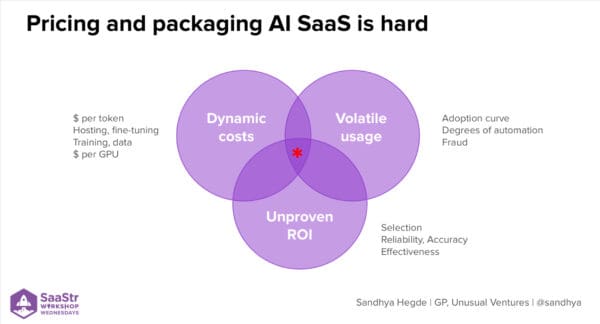
Pricing and packaging are more complex today because of three things.
- The costs are dynamic.
- Usage is volatile.
- ROI is unproven.
Let’s look further into each of these.
The Costs Are Dynamic: There’s an actual, tangible cost — dollars per token, cost of hosting, fine-tuning models, etc. If you’re a full stack or model company, there’s the cost of training, pre-training, re-training, the cost of the data itself, and curating that data. The cost of engineering and shipping products is a moving target for startups.
Volatile Usage: The adoption curve is still shifting a lot regarding how much customers use AI products. Some companies have AI features with very low frequency, but you can’t assume usage will stay low. With Notion, for example, you may use it once a week, but you can’t assume that’ll remain the same. The best case is frequency goes up.
Customer behavior is also challenging, especially with usage-based pricing and the potential for fraud. It’s a real technical problem to solve for to keep your pricing and packaging strategy and execution strong.
Unproven ROI: On the customer side, one of the big challenges for pricing and packaging is unproven ROI. Customers might ask themselves, “How do I make a big purchase when I’m not sure what my selection criteria should be? How reliable is this investment? Will it be effective and save or make me money, and how much?
The confluence of these three challenges will slowly get better over time and become more predictable. But we’re certainly not there today.
A Simple Design Framework for AI Pricing and Packaging
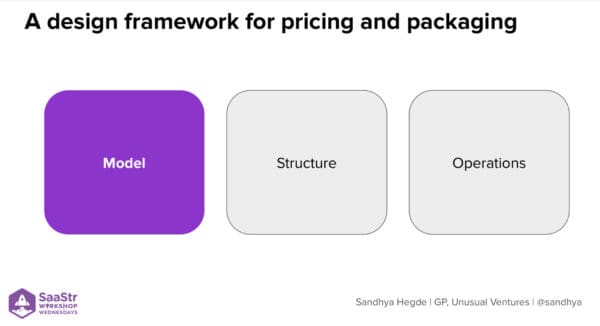
A simple framework you can use to help determine the best pricing and packaging for your product and customer segments is:
- A model for your company
- An actual structure to be trained on
- Operations that allow you to iterate, experiment, and evolve your pricing
This will never be as critical as it is today with the pace of change of your costs and the way customers are adopting the tool.
A Model for Your Company
When it comes to model, AI SaaS companies are converging on hybrid, and not necessarily the way we’ve always talked about hybrid (seats plus some usage). If you’re going up Enterprise, it could be a combination of many things depending on the customer.
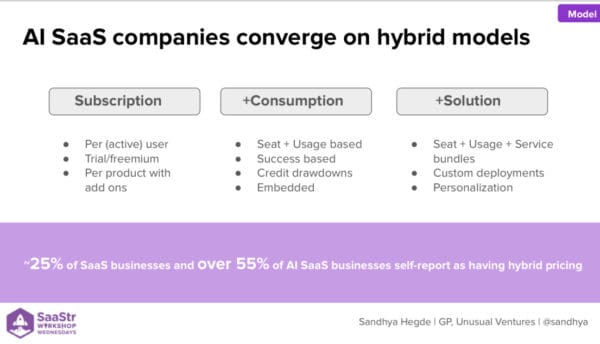
The most common pricing models are:
- Subscription — per seat or user, freemium, per product with add-ons
- Consumption — how much you’re using. Snowflake is a symbol of usage-based pricing.
- Solution — seat + usage + service, custom deployments, personalization. This is an important element to consider if you’re an Enterprise software startup because there’s a ton of change management and hand-holding needed for your biggest customers to be able to adopt your products.
A majority of AI SaaS businesses are reporting having a hybrid model, with a combination of two or all of the above pricing models. The exceptions are the ones that have extremely simple single product offerings like Character.AI.
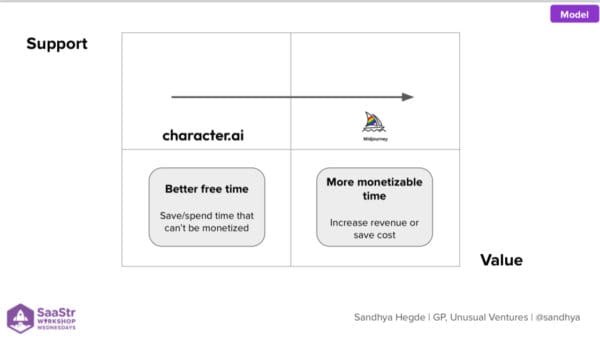
Where do you start? What is the right model for your company?
Choosing the Right Pricing Model For Your Product
Start with two questions.
- What is the nature of the value you offer?
- What is the degree of support you need?
There are two simple ways to think of value. Are you saving time? If so, can that higher-quality free time be monetized? AI saves some time, so that is a value prop, but a better question to ask yourself for determining value is, what happens to the time that you save people?
If you can’t offer people monetizable time, you can’t do usage-based pricing. It’s essential to figure out upfront if your customers require a fixed cost and can’t further monetize the time they’re freeing up or if you can monetize that time by freeing up time to support more customers or increase revenue.
The most important thing you can do is put yourself in your customers’ shoes and ask what they’re optimizing for.
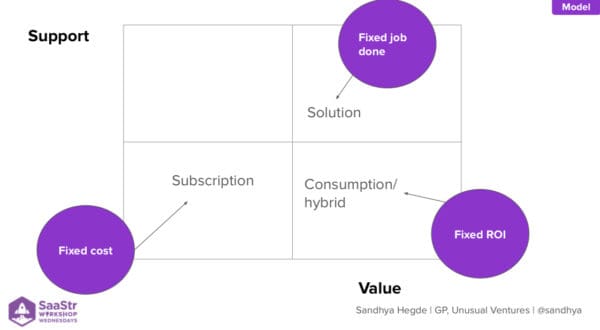
- Is the most important thing for them a fixed cost? If so, keep a simple subscription model. If there’s no way to have variable costs that they can’t predict and are sensitive to, you can’t experiment with other levels easily because the customer won’t allow it.
- Does the customer care more about fixed ROI and not fixed costs? A good example of this is everything in engineering and data infrastructure. They’re not trying to keep costs fixed. As a data engineer, if the amount of data they’re managing grows, they’re willing to increase the cost because it means the company is growing.
- With bigger companies with a lot of budget, they may optimize for getting the job done. They can’t take the risk of a project failing, and that’s where a services and solution package is critical. They might not care about seats or usage, only that the project is successfully rolled out in the company.
A Pricing Model Comparison
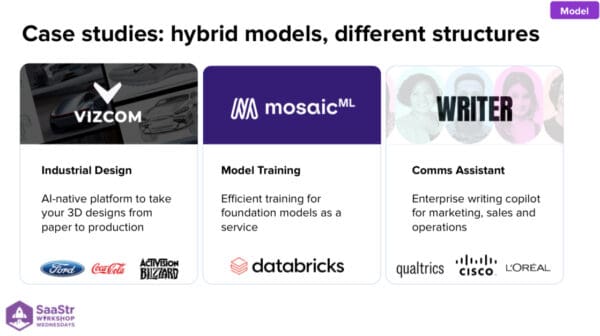
A case study of three companies shows the nuance in pricing models.
- Vizcom — in the image generation space
- Mosaic ML — model training and AI infrastructure
- Writer — in the LLM language generation space
These three AI companies are perfect examples of everything in AI right now and are seeing success in Enterprise. Yet, each has a different pricing model, and some have different pricing models for different customer segments for the same product within the same company.
An Actual Structure to be Trained On
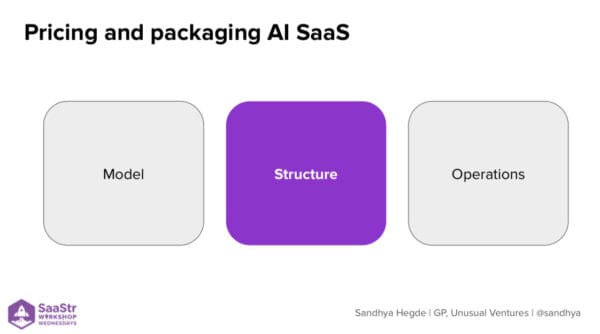
So, you’ve picked a model. Do you understand the underlying structure? Many people consider pricing and packaging as product strategy, where Product or GTM owns it. But pricing and packaging is a full company strategy.
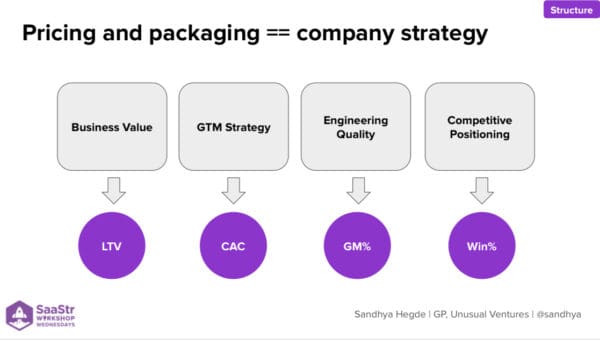
Everyone owns it. What are the inputs that go into, and what is the value you create for customers that helps determine LTV? What’s your GTM strategy, CAC, engineering quality, etc.?
Pricing and packaging say a lot about who you are trying to differentiate from and win deals away from, and all of this needs to be represented. A lot of people make the mistake of saying, “My product helps people grow their business, so I should be able to align my pricing to revenue.”
But even Salesforce doesn’t charge based on deals. They charge based on how many people are using Salesforce.
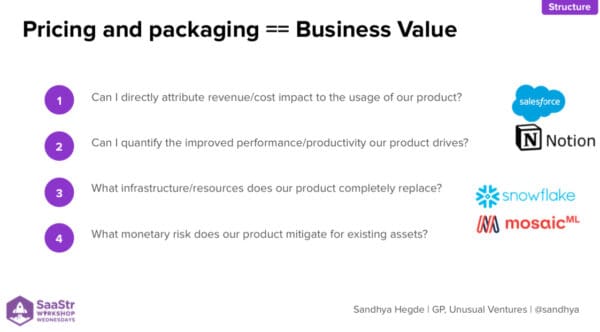
Comparing the GTM Strategy for AI tools Midjourney and Vizcom
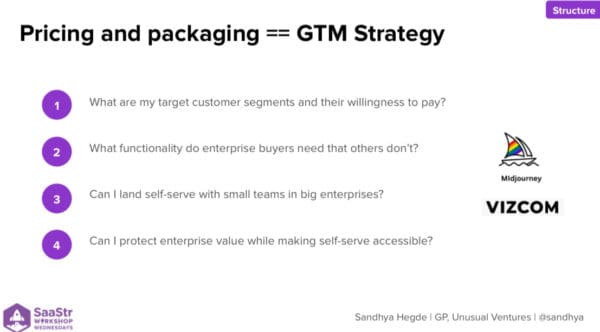
Both of these companies use diffusion models to generate images. Pricing for each, and segments within each, will differ to protect Enterprise value while also landing smaller teams within the Enterprise. You need to differentiate what the Enterprise buyer vs. the self-serve buyer cares about.
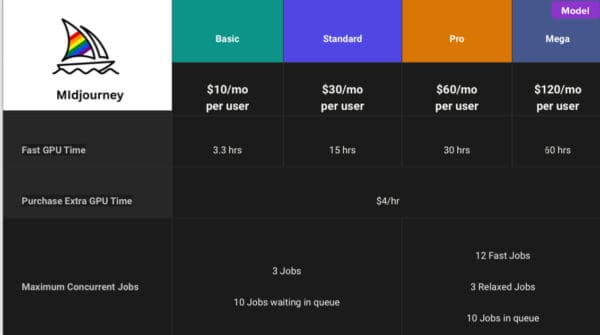
Midjourney pricing appears to be seat-based — $10/month per user. But in reality, it’s usage-based pricing because the only difference between packages is how much GPU time you’re getting, $4/hour of GPU time if you’re willing to commit upfront. That’s the entire logic of most of their pricing.
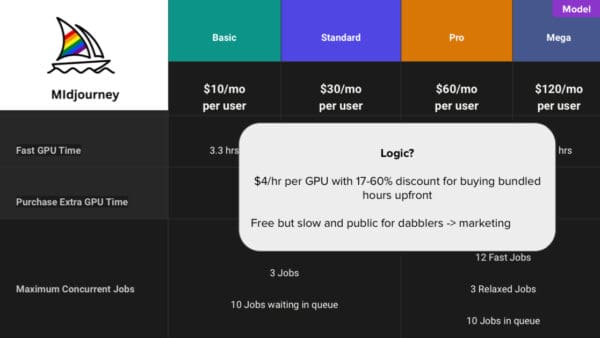
The big question is, can this work for teams? Sandhya argues this will never work for a team. If you’re a design manager with ten designers, you have no idea what your Midjourney bill will be at the end of the month because it’s a function of what those ten designers are doing with their time.
That’s terrifying for a leader, and it won’t work for Enterprise. Ironically, usage-based pricing is much more common in Enterprise products than consumer products. Freelancers and small teams love this model of paying for what you use, while big companies are terrified of being taken advantage of because it’s unreliable.
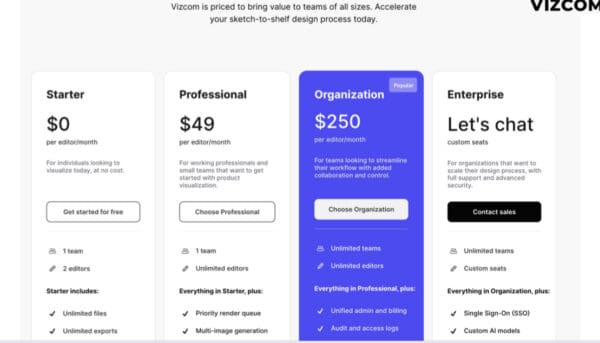
Vizcom has a free offering, like Midjourney, and then $50/month for tiny teams — mostly individual professional creatives. But, as they go upmarket, they don’t have usage-based pricing without limits. They just have a higher price point for what unlimited usage could look like, plus usage and service bundles for Enterprise with custom models for each company.
That’s what Enterprise values. Both companies are leveraging the same underlying tech, but they’ve chosen completely different pricing models because their customer segments and GTM strategies are different.
Engineering Quality Determines Pricing
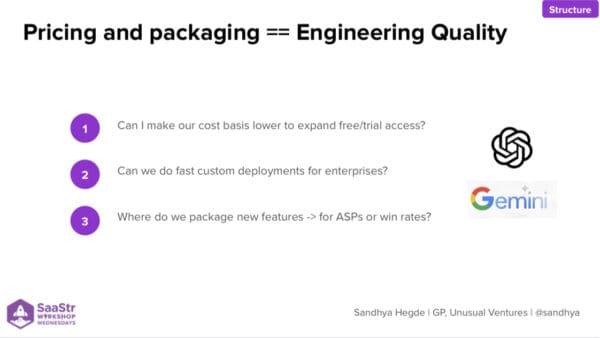
Engineering investment is the most important thing determining pricing and packaging if you’re in infrastructure dev tools. The lower your cost basis is, the more you can expand free/trial access, and the more agile your team will be with custom deployments to support Enterprise use cases.
Every time you ship a new feature, ask yourself these three questions.
- Are you going to use this to increase ASP or win rate?
- Can you make your cost basis lower to expand free/trial access?
- Can you do fast custom deployments for Enterprise?
Mosaic is a great example of this.
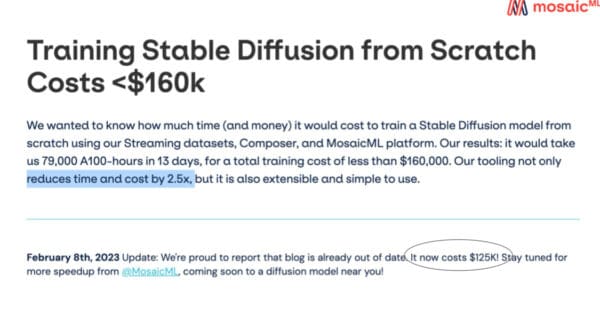
They do usage-based pricing and train models. But pay attention to the velocity. In January of ‘23, they said they could train diffusion models for $160k, which was 2.5x less than what it would cost to do it on your own. Then, in February, they already had an update saying it now costs $125k, down from $160k.
It’s a great example of what you need to do in an AI infrastructure company and how important it is to create predictability if you’re doing usage-based pricing. People need to be able to plan how much they will spend on your platform.
Competitive Positioning and Increasing Value for Customers
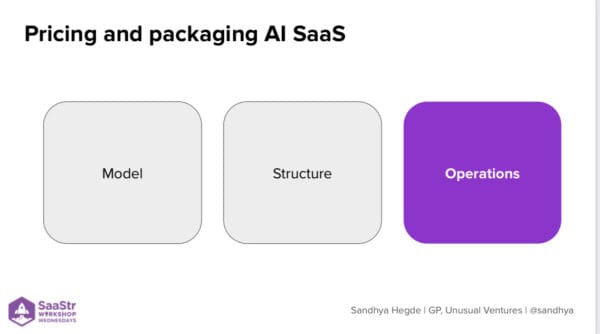
One mistake a lot of folks make is having a premium plan with a free version, and that free version is very limited. All the while, competitors have free trials of the best version of their product, and it makes your tool look silly.
Another mistake people make is going after an SMB segment when there’s a good enough free alternative. The reality is that any market with a good enough free alternative to the SMB-Mid-Market segment isn’t a compelling market.
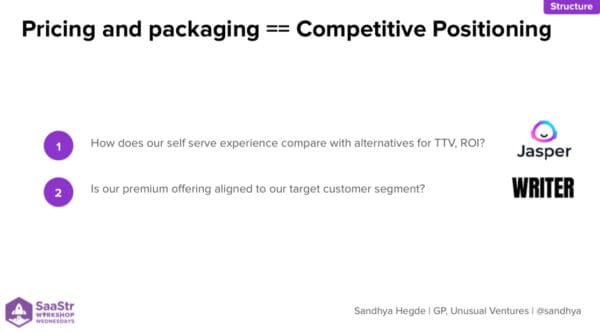
Overall, every company should try to increase the value for customers over time. If you’re not doing that, you probably won’t last. The disruption cycles in software are breakneck, so pricing needs to do a few things.
- The cost of buying your tool should always be much less than the value of using your tool.
- Provide enough value difference between you and the next best alternative.
- Your cost doesn’t need to increase monotonically.
Sometimes, your price may decrease because you’re trying to grow Enterprise value, not ASP, so you need to consider whether you’re doing it for win rate or ASP with every new feature release. It could go up and down and needs to be iterative at all times.
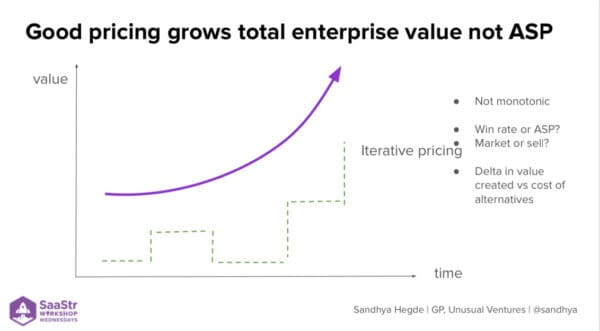
Key Takeaways
- Successful AI-native companies are fully hybrid, using different pricing models for each product, package, and customer segment.
- Customers want some sort of predictability. It could be cost, ROI, job success, or a combination of all three. So, align your package for that customer segment and what they’re trying to optimize for.
- Good packaging and pricing are all about messaging. You need to align with your customers’ mental model of how they buy software and think about tools that work for them.
- Pricing and packaging is an all-company strategy. You can’t delegate this to one person. To make it work, every functional strategy should be aligned with what you’re doing with pricing and packaging.
- It has to be iterative. A lot of infrastructure needs to be in place to execute well on growing and evolving pricing.

